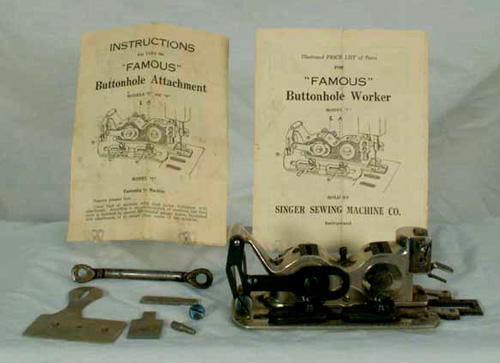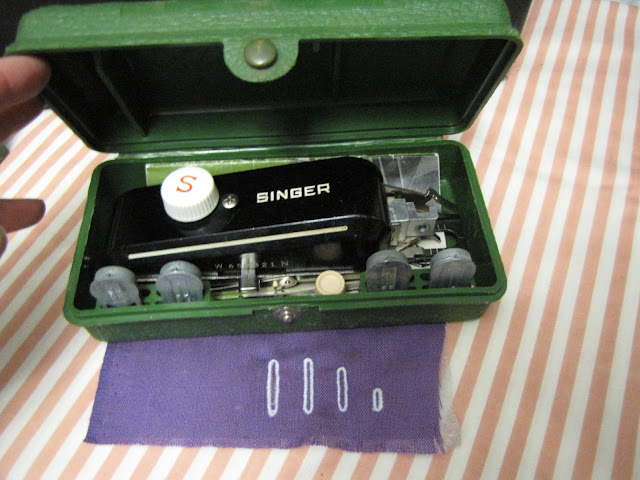Singer Buttonholers for Vintage Sewing Machines
With the popularity of home sewing machines, beginning in the 1850's, all kinds of presser feet, & special attachments were invented, to make specialty sewing easier. Once of the most popular timesaving attachments, was the buttonhole attachment, since the majority of clothing was closed with buttons, so the first buttonholer sold with Singer Sewing Machines, was described as Singer's Famous Buttonholer, though you will find it without the brand "Singer", on it, it simply says "Famous Buttonholer". Later, they were simply labeled "Singer", and they went through a metamorphosis over time.
 |
| Many buttonhole attachments have either been separated from some of their accessories, or had extras added to their cases, over time, like this Famous Buttonhole Attachment has, if you have what look like blades, of various widths, those are for cutting buttonholes open, they fit on a type of chisel handle, for safest use. They were usually sold separate from the buttonhole attachment, but came with some sewing machines, as a bonus. Screwdrivers, wrenches, and sometimes a special type of thumbscrew, to fit the thick buttonhole shank area to the presser foot bar, are required to use them, as well as a feed dog coverplate, which requires a flat screw, to attach the plate to the machine bed, during buttonhole sewing operations. |
 |
| Singer buttonhole attachment for Singer Lockstitch Family Sewing Machines, with manual, Famous buttonhole attachment for high shank industrial sewing machines. |
The earliest buttonholers I've had, include the industrial high shank sewing machine Famous Buttonholer, which fits my industrial Singer 31-15, and is a much heavier version, but the cute little Singer version, for the low shank, straight stitch only, home sewing machines, is the same model which was included with Singer Featherweight 222k, but the one with the 222k had it's own special paint coloring, cream, with red lettering, the regular Singer sewing machine buttonholer, was basic black, with white lettering. All of these early buttonhole attachments actually moved your fabric from side to side, in order to sew a zigzag buttonhole, because they are for straight stitch only sewing machines. Later, when zigzag sewing machines became common, different types of buttonhole attachments were designed for them, which no longer required the fabric to move from side to side, to sew the zigzag buttonhole stitches.


 |
| Singer Featherweight 222k Buttonhole Attachment in red plastic case, note special cream color paint, with red letters & numbering. The regular Featherweight 221 had the black paint with white lettering & numbers, & a black plastic case, though both these red & black plastic cases are quite rare, at least in the U.S.A. |
 |
| Singer Featherweight 222k shown with attachments & buttonhole attachment in it's red plastic case |
Notice, my Singer buttonhole attachment has a booklet, with instructions and a list of parts for Singer Lockstitch Family Sewing Machines, while the industrial high shank sewing machine Famous buttonhole attachment has a basic single fold booklet, with instructions, and only basic illustrations of the buttonhole attachment , labeling the various parts. These early buttonholers required you to set the buttonhole attachment itself, for the length of buttonhole you want, & set the bite (width of the zigzag stitching for the sides) of the buttonhole. For many people these seemed too complicated, but you could sew many more buttonholes, quickly, by machine, than by hand.
To see the Singer buttonhole attachment in action, see my Youtube video, click the link below, the buttonhole attachment is demonstrated in the first section of my video showing Singer Featherweight 221 with attachments.
Singer low shank straight stitch sewing machines use the old black Singer buttonholer which came in the green plastic box, or the black (more rare, for Featherweight 221) plastic box, while the slant shank Singer sewing machines required the slant shank buttonhole attachment, in the cranberry red plastic case. Occasionally, people who had both types of sewing machines & buttonhole attachments, may have mixed them up, putting them in the wrong plastic case, which is why you really need to double check which of the old buttonhole attachment shank types is in the case, before purchasing them, secondhand.
 |
| Cranberry red Singer plastic case, has the slant shank buttonholer for the Singer 301 & 401, any slant shank Singer straight stitch only sewing machines. |
Later buttonholers were even easier to use, & could sew more varieties of buttonhole styles, including keyhole style, as long as you purchased the cams for the types & sizes of buttonholes you wished to sew.
 |
| Singer "Rocketeer" style case for slant shank Zigzag sewing machine buttonhole attachment |
 |
| zigzag sewing machine attachment for slant shank Singer sewing machines |
 |
| Singer came out with a Professional Buttonholer, for their luxury slant shank zigzag sewing machines, including the Touch & Sew series. The cams for these buttonholers were plastic, with the different colors telling you if it was a keyhole cam, or a rounded ends cam, or the rectangular shaped buttonhole cam. |
 |
| I love this particular blue faux quilted plastic buttonhole case, because it has such a great organizer, including the slot for the feed dog cover! |
 |
Another version of Singer sewing machine buttonhole attachment case
|
 |
| Singer's Home Economics teacher's manuals, usually labeled "Machine Sewing Singer", on a green or blue fabric covered book, as well as many of the paperback Singer manuals for Singer Family Sewing Machines, have excellent instructions giving details on how to embroider with the buttonholers for straight stitch only machines. |
























